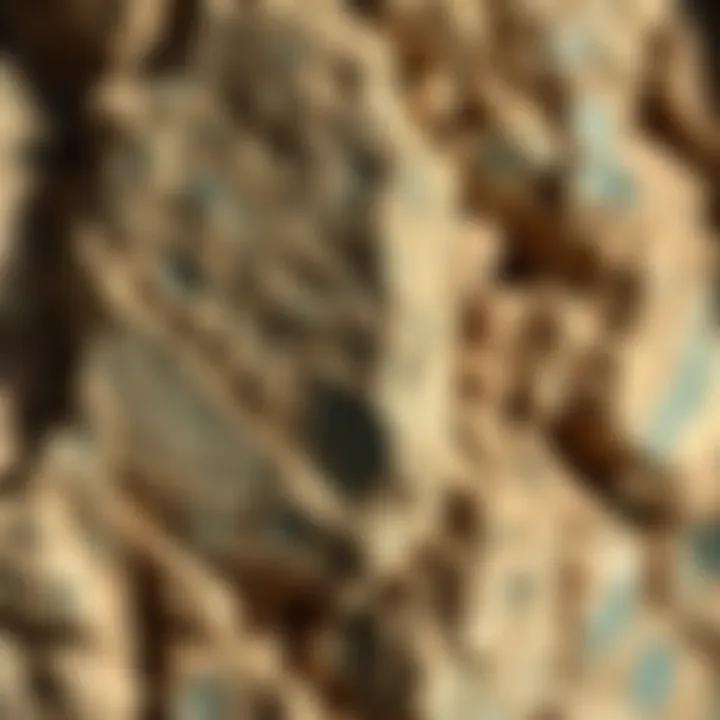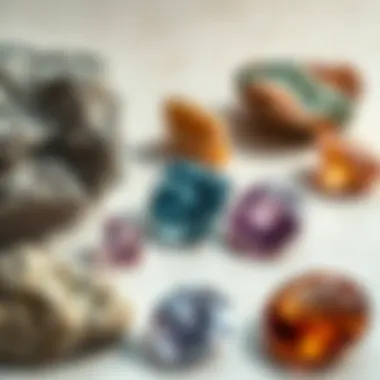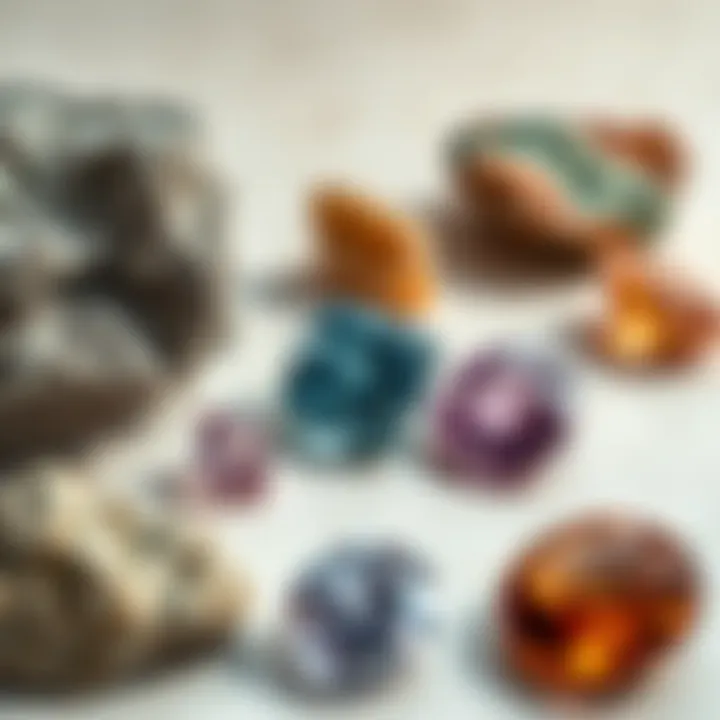Exploring the World of Rough Stone Rocks and Their Beauty


Intro
The fascinating universe of rough stone rocks offers a captivating glimpse into the depths of our planet's geology. These raw minerals, with their rugged surfaces and diverse appearances, tell stories of ancient formations and the immense forces that shaped them. Whether you are an avid collector, a jewelry designer, or just someone with a curiosity for natural wonders, understanding rough stones is a journey worth embarking on. They are not merely objects of beauty; they hold meanings and significance that echo through cultures and time.
In this exploration, we will take a closer look at the various facets of rough stone rocks. Beginning with an overview of gemstones and minerals, we will trace their historical significance to societies worldwide and examine their formations and properties. As we break down the different types of gemstones, from the conventional precious ones like diamonds to the unique and unusual varieties, we will also delve into the nuances of identifying and valuing these stones. Lastly, we’ll offer tips on proper care and preservation, ensuring you can maintain their allure long into the future.
Join us as we uncover the stories entangled in these gems and embark on a journey through the world of rough stone rocks.
Preamble to Rough Stone Rocks
The allure of rough stone rocks spans across disciplines, from geology to jewelry making. Understanding these natural wonders is more than just knowing their composition; it’s about grasping the journey they undergo from raw form to polished gemstone. This article lays the groundwork for appreciating rough stone rocks, detailing how they are formed, characterized, and identified, ultimately illuminating their cultural significance and role in the gemstone industry.
Defining Rough Stone Rocks
Rough stone rocks are essentially unpolished, raw minerals that have not been subjected to any sophisticated cutting or finishing. They can assume various forms, including boulders, pebbles, and cruder shapes. Their composition is marked by unique textures and colors that change depending on their geological origin and the environment they’ve experienced over time. Notably, these rocks can belong to a spectrum of classifications, including igneous, metamorphic, and sedimentary. The beauty of rough stone rocks lies in their imperfections—each piece tells a story shaped by the Earth's processes.
The significance of recognizing what defines these rocks cannot be overstated. They form the bedrock of many cultural artifacts and are key players in the world of gemology. To truly appreciate gemstones, one must first understand their rough counterparts. The raw, unadulterated state of rough stones serves as a canvas upon which skilled artisans craft masterpieces, revealing the inherent beauty that often goes unnoticed in everyday life.
Historical Perspectives on Stone Use
The use of stones, in various rough forms, dates back to prehistoric times. Early humans harnessed their natural shapes and durability, fashioning tools, weapons, and even symbols of power. Take, for example, the ancient Egyptians; they mined limestone and granite for their monumental structures and burial practices, crafting items that symbolized eternity and divinity. The pyramids, with their massive stones, reflect not only human ingenuity but also the reverence held for these materials.
Throughout history, civilizations have revered certain stones for their perceived mystical properties or aesthetic appeal. Ancient cultures often assigned meanings to specific types of stones—jade in China was valued for its protective properties, while lapis lazuli was associated with royalty in Mesopotamia. The intrinsic link between a society's material culture and the rough stones they utilized offers rich insight into their values and beliefs.
In contemporary contexts, the significance of rough stone rocks persists. They play a pivotal role in modern archaeology and geology settings, where unscripted elements reveal layers of history and environmental changes. The study of stone use continues to provide crucial lessons about human adaptation and resource utilization, making the understanding of rough stone rocks not just a niche interest but a key component of our global heritage.
Formation of Rough Stone Rocks
Understanding the formation of rough stone rocks provides a foundational insight into geology and the nature of minerals. This topic bears significance not just for enthusiasts in the field, but also for those interested in the aesthetic and practical uses of stones in various applications, from jewelry making to architecture. Grasping how rough stones are formed elucidates their properties and potential applications. Each type of rock undergoes unique processes that create distinct characteristics, making them valuable in different contexts.
Geological Processes Involved
The formation of rocks is akin to crafting a recipe; it requires the perfect combination of ingredients and conditions. Geological processes play a paramount role in this recipe, featuring elements like temperature, pressure, and time. Let’s consider how each of these factors contributes:
- Igneous processes: These begin with molten rock, known as magma, which can either cool slowly beneath the surface or erupt violently from a volcano. Cooling rates significantly affect the crystal size within the rock. Slow cooling fosters larger crystals, creating rocks like granite that are popular in construction due to their strength and beauty.
- Metamorphic processes: This type of formation occurs when existing rocks—be they igneous, sedimentary, or other metamorphic rocks—experience extreme pressure and temperature changes. Slate serves as a prime example. It originates from shale under heat and pressure, morphing into a more durable and often beautiful stone used in roofing and flooring.
- Sedimentary processes: Here we find a unique story. Sedimentary rocks often form in layers, sequentially accumulating over time from organic materials, minerals, and sediments carried by wind or water. The end result, like sandstone or limestone, can showcase historical narratives through its layers, making it not only a building material but also a repository of history.
Types of Rock Formations
The world of rough stone rocks diversifies even more when we categorize them into types based on their formation processes. Each classification not only highlights their origin but also showcases unique characteristics beneficial for various uses.
Igneous Rocks
Igneous rocks stand out due to their origin from molten material. They are often categorized as either intrusive or extrusive. Intrusive igneous rocks, such as granite, form when magma cools slowly within the Earth, resulting in large, well-formed crystals. The cool-down process here is gradual, allowing for a detailed, complex crystal structure. Extrusive rocks, like basalt, emerge when magma erupts and cools rapidly on the surface, resulting in smaller crystals. The advantage of igneous rocks lies in their exceptional hardness, making them ideal for tools and as foundational materials. However, their weight can pose challenges in certain applications.
Metamorphic Rocks
Metamorphic rocks bring another fascinating dimension to rough stones. They represent a transformative journey, where pre-existing rock types are altered by heat and pressure. This can lead to the creation of visually striking textures and patterns, such as the banded appearance in gneiss. Metamorphic rocks are often sought after for decorative purposes, owing to their unique aesthetics. Yet, extracting and processing them can be more complex than their igneous counterparts.
Sedimentary Rocks
Sedimentary rocks tell stories of bygone eras. Over time, layers accumulate, preserving organic materials and minerals. Noteworthy examples include limestone, which often contains fossils, serving as a window into ancient life. Their layered structure provides a unique visual appeal, making them popular in construction and art. However, their porous nature may limit their use in certain conditions, such as in wet environments.
The characteristics and formation of rough stone rocks constitute an intricate web of geological history. Understanding these processes equips us with the knowledge to appreciate the value and applications of natural stones in our lives.
Characteristics of Rough Stone Rocks
Understanding the characteristics of rough stone rocks is crucial for anyone looking to delve into geology or the gemstone industry. These characteristics determine not only the aesthetic appeal of the stones but also their usability, durability, and value in various applications. Examining these features can aid in identification, classification, and even understanding the history these ancient materials carry.


Physical Properties
Physical properties of rough stone rocks encompass several key elements that define their appearance and structure. These include color variations, texture and luster, as well as hardness and density. Each of these properties plays a pivotal role in creating distinct identities for various types of rough stone rocks.
Color Variations
Color is often the first characteristic noticed in rough stones, and it can vary dramatically across different types. From vibrant blues seen in lapis lazuli to the muted earthy tones of basalt, color variations are vast. This diversity not only adds visual interest but also aids in the identification process. Specific minerals contribute to these colors; for instance, the presence of iron can result in reddish hues.
The wide array of colors makes rough stone rocks a popular choice for use in jewelry and decorative items. Stones with striking colors tend to fetch higher prices, making their aesthetic appeal a significant factor in the gemstone market. However, it’s worth noting that color stability can be affected by environmental factors, which may lead some gemstones to fade or change over time.
Texture and Luster
Texture refers to the surface feel and appearance of rough stones, while luster describes how light interacts with their surfaces. Some stones, like marble, can have a polished finish that reflects light beautifully, while others, like granite, may appear more rugged and matte. The unique texture and luster not only enhance the visual attractiveness of these rocks but also play a crucial role in their usability. For instance, smoother stones are often favored in jewelry making because they are comfortable against the skin and simply more visually appealing. However, naturally textured stones may appeal to certain artistic styles or applications, allowing for a broader range of uses.
Hardness and Density
Hardness and density are fundamental characteristics that influence both the practical and aesthetic aspects of rough stone rocks. The Mohs scale rates hardness from 1 (talc) to 10 (diamond), providing a clear understanding of a stone's durability. For example, materials like quartz rank around 7, bringing a balance of resilience and workability for gem enthusiasts and collectors alike. Further, density impacts how stones are perceived and worked. Heavier stones may suggest durability but can be more challenging to cut and polish. Conversely, lightweight stones might be easier to handle yet can raise questions about their sturdiness. An understanding of hardness and density can be invaluable for both collectors who seek durable specimens and jewelers who require manageable materials for their projects.
Chemical Composition
Chemical composition determines the overall properties of rough stone rocks, influencing everything from color to strength. The minerals present not only give unique attributes but also tell a geological story of how and where the rock was formed. Identifying the chemical makeup can be crucial for various uses, particularly in artisanal craftsmanship and science. Each rock, like granite or limestone, carries specific mineral assemblages that reveal much about its formation process, aiding enthusiasts in discerning their origins and values in the marketplace.
Identification of Rough Stone Rocks
Identifying rough stone rocks is a cornerstone of understanding their traits and potential applications. Without accurate identification, one can easily misinterpret the type and value of a stone. This section explores why recognizing these rocks correctly is so crucial, delving into both the scientific and practical aspects that surround their identification.
Grasping the nuances in stone characteristics not only aids geologists and gemologists but also benefits enthusiasts and collectors by enhancing their appreciation of these natural wonders. Moreover, it facilitates informed decisions about the use of the stones in various contexts, such as jewelry making, construction, or even art.
Methods for Identification
Visual Characteristics
When it comes to initial identification, visual characteristics stand out as the most accessible method. The colors, patterns, and surface texture of rocks can provide immediate clues to their identity. For instance, the striking banding in agate is a hallmark that helps collectors determine its type. This visual aspect is a beneficial choice because it allows enthusiasts to initiate their identification process without needing specialized tools or advanced training.
A unique feature of visual characteristics lies in their variety; the crystalline structures seen in quartz or the glimmer of mica can lead someone to spot a gem amongst regular stones very swiftly. However, the downside is that relying solely on eyesight can sometimes lead to errors if one does not have a practiced eye or understanding of the subtle differences between similar stone types. Thus, while visual assessment kicks things off, it often invites further scrutiny through additional methods.
Field Tests
Field tests add another layer of depth to rock identification, allowing for a hands-on approach that confirms visual assessments. These tests often include simple methodologies such as streak testing or hardness comparisons, which help differentiate between stones that might otherwise seem identical. Streak tests, for example, involve scratching the stone on a porcelain plate to observe the powder it leaves behind, providing valuable information about its mineral composition.
The advantage of these tests is twofold: they are accessible to novices yet provide reliable results that professionals trust. However, one potential disadvantage is that some tests can slightly damage the rock, which might be a concern for collectors wanting to keep their specimens in pristine condition. Nevertheless, field tests often serve as the bridge between visual identification and more in-depth analytical methods.
Tools for Rock Identification
Hand Lens
A hand lens is a simple yet powerful tool for rock enthusiasts. Its primary role is to magnify the surface of a stone, revealing features that are otherwise imperceptible to the naked eye. With a hand lens, collectors can observe fine details like crystal formations and surface scratches that indicate wear and tear.
The key characteristic of the hand lens is its portability and ease of use, making it a beneficial tool for anyone from amateurs to seasoned geologists. It enhances the depth of examination without requiring costly equipment. However, the drawback is that lighting conditions can affect what is visible through the lens; if the light is poor, it might give a false impression of the rock's color and texture.
Saw and Grinder for Cut Surface
For those looking to dive deeper into rock analysis, using a saw and grinder to create a cut surface provides unparalleled insight. This method reveals the internal structure and layering of the rock, showcasing its true form. The polished surface can bring out the natural luster and colors that might remain hidden in a rough stone.
The key advantage of this method lies in its ability to transform a stone into a piece of art, essentially. It plays a vital role in gemstone preparation and can dramatically influence the valuation of a stone. On the flip side, using saws and grinders demands skill and can be intimidating for beginners. Missteps could lead to irreversible damage or wasted materials. Thus, it is more suited for serious hobbyists or professionals.
Understanding the methods and tools of identification is essential for any enthusiast or collector eager to explore the diverse world of rough stone rocks. The foundational appraisal techniques open the door to more intricate studies and applications, ensuring that each stone is appreciated for its unique beauty and potential.
Rough Stone Rocks in Gemstone Industry
The rough stone rocks are not just mere geological formations but the heart of the gemstone industry. Their journey from rough, unrefined specimens to exquisite pieces suitable for high-end jewelry entails a fascinating blend of market dynamics, processing techniques, and artistry. Understanding their place in the market and the techniques employed in their refinement can significantly benefit enthusiasts and professionals alike in this vibrant field.


Market Trends and Valuation
Today’s gemstone market is constantly shifting, influenced by factors such as consumer preferences, eco-conscious buying trends, and the rarity of certain types of rough stone rocks. In recent years, there has been a discernible uptick in demand for ethically sourced gemstones, which has undoubtedly impacted valuation. Vintage stones, especially, have regained popularity, resonating with collectors looking for unique pieces with history.
In addition, gemstones like sapphires and rubies are no longer the only players; a new wave of interest surrounds lesser-known stones like the teal-colored blue zircon or the vivid lavender amethyst. As collectors dig deeper, they search for stones that not only sparkle but come with stories of sustainability and responsible sourcing.
"Rough stone rocks serve as a gateway, turning gems mined from the Earth into treasures worn with pride."
This shift in consumer behavior has led to a shift in how rough stone rocks are valued. Market analysts are now factoring in the origin stories, such as where the stone was mined and the mining practices used, ultimately affecting how gemstones are traded. Consequently, the potential for increased profits in ethical sourcing is more than just a trend; it's a movement rooted in social responsibility and environmental stewardship.
Processing and Cutting Techniques
The transformation of rough stone rocks into polishing gemstones hinges heavily on the techniques used during processing and cutting. The two predominant methods, sawing and grinding, each play pivotal roles that are as distinct as they are essential.
Sawing
Sawing is often the first step in the cutting process, and its primary aim is to slice rough stones into manageable pieces. What makes this technique particularly advantageous is its ability to maintain the integrity of the stone while making meaningful cuts. The key characteristic that sets sawing apart is its precision—experienced lapidaries can calculate the optimal angle to minimize waste, maximizing the yield from each rough stone.
The unique feature of sawing lies in its straightforward, efficient approach. This technique involves the use of diamond-tipped saw blades that cut through even the toughest materials. While it does require a certain level of expertise to execute without cracking the stone, the benefits far outweigh the disadvantages, offering clarity and depth to stones that might otherwise remain hidden under a rough exterior.
Grinding
On the other hand, grinding compliments the sawing process. After sawing down to size, grinding smooths out the stone's surface, preparing it for the final polishing stages. The beauty of grinding is how it reveals the stone's true essence, bringing out its color and luster in a way that sawing cannot achieve alone.
A significant characteristic of grinding is its versatility; different grits of grinding wheels can be used to accomplish various finishes, from a rough texture to a high shine. However, this approach does carry the risk of overheating, which can damage the stone if not monitored closely. Still, the advantages in enhancing the stone's appeal and character make grinding an indispensable part of gemstone processing.
In summary, every stage of working with rough stone rocks in the gemstone industry embodies a meticulous process steeped in tradition and innovation. By understanding market trends and the significance of processing techniques like sawing and grinding, gemstone enthusiasts and professionals can appreciate the artistry involved in turning these natural resources into valuable treasures.
Cultural Significance of Rough Stone Rocks
Rough stone rocks carry considerable weight in both cultural and artistic realms. Their raw beauty and inherent uniqueness foster creativity, allowing artisans and jewelers to craft stunning pieces of art and daily wear gems. Understanding the cultural significance of these stones provides insight into historical contexts and modern applications, strengthening connections across generations.
Use in Jewelry and Art
Cultural Artifacts
Cultural artifacts made from rough stone rocks often serve as historical markers, reflecting the beliefs, practices, and traditions of civilizations long gone. These artifacts, such as carvings or sculptures, can tell stories that words might not convey, revealing complex narratives that stand the test of time. One example includes ancient jadeite carvings from Mesoamerica, which were not just decorative but also represented status and power within their societies. The key characteristic of these artifacts is their ability to connect us to the past, making them popular choices for collectors and historians alike.
However, the use of rough stone in creating cultural artifacts does bring its challenges. Preservation can be difficult, as natural elements may deteriorate their surfaces over time, posing risks to their longevity. Nonetheless, this uniqueness only adds to their charm, making these artifacts truly irreplaceable treasures.
Contemporary Jewelry Designs
Contemporary jewelry designs have embraced rough stone rocks for their raw and organic appeal. Designers create pieces that highlight the natural shapes and textures of the stone rather than polishing them to perfection. This trend speaks to a growing appreciation for authenticity and individuality in modern society. For instance, pieces featuring unpolished quartz or raw diamonds have surged in popularity, as they stand in stark contrast to traditional, uniform gems.
The key characteristic here is the embrace of imperfections. This not only allows for unique creations that feel personal but also resonates with the eco-conscious movement, encouraging sustainable practices by reducing waste in the jewelry industry.
Nevertheless, contemporary jewelry can face drawbacks; rough stones can be less durable compared to their polished counterparts, requiring more care in wear. Yet, the allure of owning a piece of nature that is one-of-a-kind keeps collectors and enthusiasts drawn to these innovative designs.
Symbolism and Folklore
The symbolism surrounding rough stone rocks often runs deep, intertwining with local folklore and traditions. Many cultures assign meanings to specific stones, believing they carry protective or healing properties. For example, amethyst is often seen as a stone of tranquility, promoting calmness and balance. In folk traditions, stones may appear in tales that explain their mystical origins or connection to earth spirits.
Consequently, every stone isn't merely a falling pebble; it's a chapter of human experience shaped by time and culture. > "The power of a stone is not just in its physicality but in its ability to invoke a deeper understanding of ourselves and our surroundings."
Exploring these mythologies contributes to the appreciation of rough stone rocks, making them more than just minerals; they're vessels of history and stories waiting to be uncovered.
As we examine the cultural significance of rough stone rocks, it becomes crystal clear that their impact stretches far beyond mere aesthetics. They serve as connections to human experiences, representing the age-old pursuit of beauty and meaning in our lives.


Environmental Considerations
Understanding the environmental considerations surrounding rough stone rocks is crucial in today’s context, given the increasing awareness of ecological sustainability and the impact of mining activities. The extraction and processing of these stones can significantly affect local ecosystems, yet with suitable practices, these effects can be mitigated. Delving into sustainable mining practices not only serves to preserve nature but also offers long-term benefits to businesses and communities involved in the stone industry.
Sustainable Practices in Mining
The notion of sustainability in the mining sector is gaining traction, particularly among gemstone enthusiasts and industry players. Sustainable mining practices aim to balance the demand for rough stone rocks with the need to protect environmental resources. Some notable practices include:
- Responsible Sourcing: It involves mining operations that are transparent and ethical, ensuring that the exploited areas are not detrimental to the surrounding environment.
- Rehabilitation of Mined Areas: After extracting stones, companies are encouraged to rehabilitate the landscape, restoring it as close to its original state as possible to support local flora and fauna.
- Water Management: Efficient use of water resources helps mitigate the impact of mining. Implementing closed-loop systems for water use during the cutting and polishing processes is one way to conserve this vital resource.
- Reduction of Waste: Advanced processing techniques can help minimize waste production. Companies employing methods that allow for efficient extraction can reduce debris, making the operation greener overall.
Sustainable practices in mining help to produce rough stone rocks without leaving a heavy environmental footprint, which in turn can improve their marketability and appeal to eco-conscious consumers.
Impact of Mining on Ecosystems
Mining activities, if unchecked, can lead to significant ecological disturbances. These disruptions go beyond visual impacts to affect various aspects of local ecosystems:
- Habitat Destruction: The removal of vegetation and topsoil during mining can lead to loss of habitat for native species, displacing wildlife and disrupting biodiversity.
- Soil Erosion: Without the stabilizing effects of plants, soil can erode more easily, leading to sedimentation in nearby rivers and negatively impacting aquatic life.
- Water Pollution: Mining runoff can introduce toxic substances into local waterways, harming both animal and plant life and even affecting human communities relying on these rivers for water.
- Carbon Footprint: The mining and processing phases often involve the use of heavy machinery that contribute to greenhouse gases, further aggravating climate change issues.
In light of these impacts, it becomes essential to establish stringent regulations and promote practices aimed at protecting ecosystems.
"Sustainability isn't just a trend; it’s a necessity for our future. Responsible mining can foster a balance between economic development and environmental stewardship."
By addressing these environmental considerations, stakeholders in the rough stone industry can help ensure that mining activities foster both economic viability and environmental health, thereby ensuring a sustainable future for the gemstone market.
For those wanting to delve deeper into this subject, consider reading more at Wikipedia, Britannica, and Reddit.
Future Prospects of Rough Stone Rocks
The domain of rough stone rocks is not just rooted in history; it’s also a canvas for the future. With the steady evolution of both technology and consumer preferences, understanding the prospects of these minerals becomes crucial for enthusiasts, collectors, and industries alike. This section takes a closer look at what lies ahead for rough stone rocks, which encompasses emerging trends in gemstone collecting and advancements in rock cutting techniques that could redefine their use and valuation.
Emerging Trends in Gemstone Collecting
Gemstone collecting has always been a passionate pursuit for many, but recent trends point to a noticeable shift. The rise of social media and online marketplaces has made it easier than ever for collectors to connect and showcase their finds. What used to be a local hobby has now become a global phenomenon.
- Sustainability is trending, as collectors increasingly seek ethically sourced stones. The demand for transparency regarding the origins of gemstones is growing, prompting miners and suppliers to adopt responsible practices.
- Digital Collecting is gaining momentum. Virtual auctions and online platforms allow collectors to view and purchase stones from across the globe without ever leaving their homes. This shift is revolutionizing the market, making rare finds accessible to a broader audience.
- Community Building has transformed how collectors interact with each other. Online forums, social media groups, and even mobile apps are fostering a sense of camaraderie among enthusiasts. These platforms facilitate knowledge sharing and allow individuals to trade tips and techniques for identifying and caring for their collections.
As gemstone collecting evolves, it will be interesting to observe how these trends will shape the future of rough stone rocks, influencing everything from market dynamics to the types of stones that are valued.
Technological Advances in Rock Cutting
The art of cutting and polishing rough stones is undergoing a noteworthy transformation, thanks to technological advancements. High-tech tools and techniques are enhancing precision and efficiency in processing these natural wonders.
- Laser Cutting is leading the charge, offering unprecedented accuracy. Instead of traditional saws, artisans can now utilize lasers to create intricate designs with minimal loss of material. This method preserves more of the rough stone, allowing for more stones to be fashioned into beautiful pieces.
- Computer Numerical Control (CNC) Machines are also making waves in this sector. These machines automate the cutting process, ensuring high levels of consistency in shapes and dimensions. This tech facilitates mass production while maintaining quality, which is crucial for market demands.
- Innovative Polishing Techniques are improving the finish of stones, providing that sought-after gleam that draws buyers. For instance, ultrasonic polishing uses sound waves to achieve a smooth surface, reducing the need for harsh chemicals that could otherwise damage the stone’s integrity.
Technological improvements not only promise a brighter future for jewelers but also enhance the experience for collectors, ensuring they receive high-quality products that retain their natural beauty.
The evolving landscape of gemstone collecting and stone cutting is ushering in new opportunities and challenges, urging all stakeholders to be adaptable and informed.
As we look to the future, it’s clear that rough stone rocks hold immense potential, not just in terms of financial investment, but also in fostering a deeper connection between individuals and the earth’s natural treasures.
Culmination
The journey through the realm of rough stone rocks unfolds a tapestry of geology, artistry, and environmental awareness. Understanding this topic is essential as it not only highlights the intricate processes that shape these stones but also sheds light on their significance in cultures across the globe. Each rough stone possesses characteristics that serve as a gateway into deeper exploration, from their formation underground to their transformation into cherished gemstones.
Recap of Key Points
Throughout this article, we have traversed various facets of rough stone rocks. To summarize:
- Definitions: Rough stone rocks, defined by their natural state, form the basis for many gemstones and decorative arts.
- Geological Formation: Understanding the geological processes, such as sedimentation and metamorphism, gives insight into how these rocks are created.
- Characteristics: We discussed the physical properties like color and hardness, as well as their chemical compositions.
- Identification Methods: The need for precise identification, whether visually or through field tests, ensures the accuracy in both the scientific study and the trading markets.
- Gemstone Market: The trends affecting valuation and processing techniques illustrate the ongoing relationship between nature and economy.
- Cultural Significance: Here, we recognized the role of rough stone rocks in art and symbolism, connecting people to their heritage.
- Environmental Considerations: The repercussions of mining practices on ecosystems necessitate a responsible approach to sourcing these rocks.
- Future Prospects: Emerging trends and technology paint a promising future for gem collectors and designers, showing the evolving landscape of the industry.
Final Thoughts on Rough Stone Rocks
"In the eyes of stone and the hands of artisans, hidden stories await to be unearthed."
For more in-depth insights, readers are encouraged to visit resources such as Britannica, Wikipedia, and relevant geological studies hosted on academic platforms like ResearchGate.







